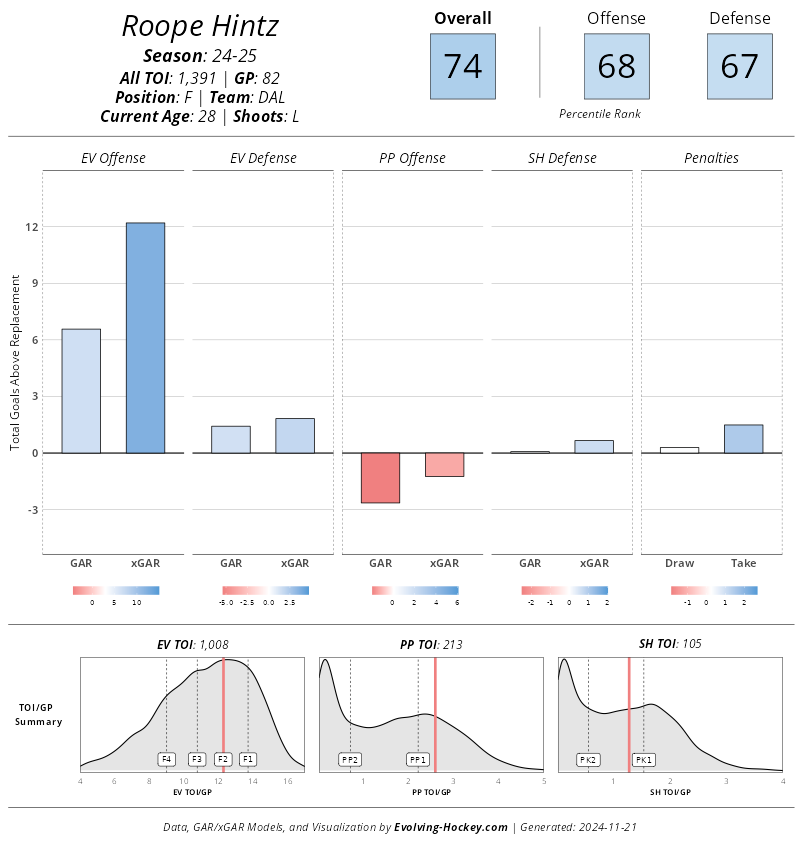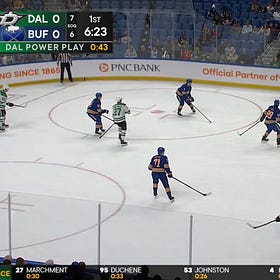Into the weeds with Corey Sznajder's microdata on the Dallas Stars (and a digression on Roope Hintz)
Back to formula for Dallas' top center.
It was a good night versus San Jose the other day.
A lot of the big names experiencing cold streaks got on board, between Roope Hintz, Jason Robertson, and Wyatt Johnston. Granted, it was against one of the worst teams in the league — but again, you can only beat who’s in front of you.
I’m not gonna talk too much about the San Jose game, except to say that Johnston and Robertson were a lot less noticeable outside of their goals than Hintz. Whereas I thought Johnston looked only okay (had one great shift, and one particularly bad one that I forgot to clip), while Robertson seemed invisible prior, Hintz looked like he had his spinach, salmon soup, and senzu beans all at once.
It was, frankly, great to see, although you wonder why it took so long for this version of Hintz to pop up. Hintz has been an odd duck. While the Hintz-Robertson connect is likely the source of their respective struggles, Robertson at least has an excuse. Hintz does not. However, the numbers are a lot more kind. We’re not at the point where it’s worth digging too deep into the numbers, but so far, Hintz looks marked for “hell’s coming with me.” In fact, his impact on expected goals is literally double his impact on observed goals.

The goals will come. However, there’s a major asterisk. It looks like the goals will come at even strength. The power play is a disaster. Pretending that this current sample of games will predict the future, this data Hintz should be cold all year. Should Stars fans be worried in this respect? Yes and no. Hintz was really good on the power play last year.
A digression: about the power play
The real question then, is whether the power play machinations will get in the way. I’ll write about the PP eventually. I’ve already covered it, and while I stand by it, I want to wait a bit to see exactly how right or (more likely) wrong I am.
Tales From The Clipped: Understanding the seven-second rule, and Dallas' struggling power play
Normally, today is the day we go over Corey Sznajder’s tracking data, getting granular with the how of hockey outcomes. But today I’m making an exception to talk about Dallas’ power play, which, as everyone knows, is struggling. With a 9.5 conversion rate, and above only only two other teams, that’s being incredibly diplomatic.
Nobody can understand the climate by looking at the weather. So yes, you’re justified in sharpening your pitchfork, but it hasn’t even been 20 games. There will be time to lunge with the pointy end facing Steve Spott’s way, but that time is not now. Especially while so may of Dallas’ best forwards have struggled away from the man advantage.
Back to Hintz
Hintz is someone I consider a contradiction. He’s an obviously talented player with deficiencies fans tend to skip (lack of puck handling, and lack of elite agility), and strengths that get overlooked (routes, reads, defensive zone play, etc), which is in keeping with the tradition of “underrated.” Underrated players tend to be players with more layers than meets the eye, but the fact that we have to look harder than usual omits the fact that obvious skills — Ovechkin’s shot, MacKinnon’s gear shifting, etc — are just as, if not more valuable.
So it was with great surprise when this happened.
To me this play illustrates why it’s so essential for Hintz to have two players with interlinking skills and not just one. Consider all the elements that had to come together: Robertson being able to maximize Hintz’ lane speed with that quick decision pass, Harley getting a shot on net instead of having it go straight into the opponent’s shin pads, Robertson winning his corner battle, and Johnston being in position to shoot (although his reflexed failed him here). It’s actually quite rare to see him use his edges for speed in the corners. Granted, San Jose is defending him poorly, but the newlook top line has potential to dominate anyone.
So hopefully this is all of sign of things to come. The reason why I’m focusing on Hintz is because as good as Johnston is, I still consider Hintz its top center, and when he’s firing on all cylinders, that’s where he belongs. Don’t look now, but he’s quite literally lost that role. Johnston now averages slightly more minutes than Hintz. Whether or not that’s justified — or if it even matters — is a separate story. But I do think, for now, this Stars team as at its best when its top center is playing the role he’s traditionally had.
One last thing I’ll say about Hintz, and then we’ll dig into the microdata, because I think some interesting patterns are emerging. As always, big thanks to Corey Sznajder for the introduction of his Bedard Tier, which makes this analysis possible, and big thanks to paid subscribers for making it possible for me to do this.


